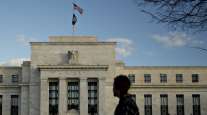Economists See Slow Growth for United States, Trucking

This story appears in the Oct. 10 print edition of Transport Topics.
LAS VEGAS — The low-growth U.S. economy remains in place and will probably continue plodding along as business leaders are hesitant to make the sort of investments that boost gross domestic product, in general, and truck freight volumes, specifically.
Two economists pointed out during a panel discussion here on Oct. 2 the relative winners and losers in a weak economy, which is still better than most other nations.
“It’s a very fragile world now,” economist Diane Swonk said at the Management Conference & Exhibition of American Trucking Associations.
MCE PHOTO GALLERY: Best pictures from Las Vegas
COMPLETE MCE COVERAGE: Live stories, photos, video, social media and more
Swonk said this year will probably be the weakest year for U.S. growth since the Great Recession ended. She said there are signs the economy is now “moving in the right direction, but it’s going slowly, like running in mud.”
ATA Chief Economist Bob Costello hosted the annual discussion and said trucking has suffered this year from a painfully slow correction in high inventories and weak manufacturing.
Swonk said economic woes abroad led to a very strong dollar that made U.S. exports too expensive to buy. Costello said less-than-truckload carriers and steel haulers have borne the brunt of that.
However, Costello also said trucking executives should be careful about attacking international trade, as commerce among the United States, Canada and Mexico has supported North American freight services.
“In the post-North American Free Trade Agreement era, we’ve seen growth in exports moved by truck outstrip overall growth of domestic freight over the past two decades,” Costello told fleet and other industry executives.
Costello dissected recent industry performance by sector. In contrast to steel haulers in the flatbed sector, he said the same sector that specializes in hauling building products is doing well.
He said U.S. flatbed loads transported so far this year have grown by 6.6% compared with the same time last year. Flatbed loads had contracted in 2014 and 2015.
While Costello’s ATA tonnage index has shown growth for much of the year, he said the number of loads hauled is either flat, year-over-year, or in decline, depending on the sector.
“We’re seeing clear deceleration,” he said of load volumes.
Refrigerated loads have grown only modestly this year, by 0.7%, after booming by 14.3% in 2015.
Tank truck loads have grown by 0.3% this year, he said, but that comes after a 1.1% contraction in 2015.
Less-than-truckload tonnage has been more stable, contracting by 0.5% so far this year, after expanding by 0.9% in 2015.
Costello also said industry capacity, as measured by fleet size, has been split. Large truckload carriers have trimmed fleet size by 4.4% so far this year, whereas small truckload carriers, with $30 million in annual revenue or less, have boosted their tractor counts by 6.5%.
Expansion for small fleets has been easy, Costello said, because the strong supply of used trucks has driven down their prices substantially.
Looking at oil production and prices, Swonk was optimistic. She said she anticipates the price of crude oil will remain in the $40 to $50 a barrel range that she described as a “sweet spot,” not so high as to hobble consumers but high enough to reward oil producers.
Costello said he is “hopeful that we are nearing the bottom of this [weak economic] cycle and will soon expect a modest rebound.”
Swonk said corporations are doing well enough to engage in stock buy-back programs to boost share prices and offer dividends to stockholders, but they are holding back on investments that could lead to significant growth.
In an interview after her remarks, Swonk said she is not a pessimist, but following the economy can produce frustration.
“Things should be kicking in, but CEOs are not pulling the trigger” on investment plans.
“They don’t want to make a bet on the future. This is hesitation on their part, not pessimism,” Swonk said.
Monetary policy is in flux, Swonk said, with top Federal Reserve officials in disagreement. She said Fed Chairman Janet Yellen and Vice Chairman Stanley Fischer favor keeping interest rates low. In contrast, many of the 12 regional Fed bank presidents want to start raising short-term rates slowly.
Swonk said Yellen and Fischer think the U.S. labor market is still somewhat weak and that raising interest rates would harm it.
Swonk also said Yellen and Fischer have a more international perspective and that an increase in rates here could have debilitating economic affects abroad, which would make business worse for U.S. exporters.
For the regional presidents, they’re worried about continuing low rates, Swonk said. Price inflation is not soaring but it is rising, and the regional bankers worry the Fed will not be able to help the economy by cutting interest rates in the future if they never rise above the current low point.




